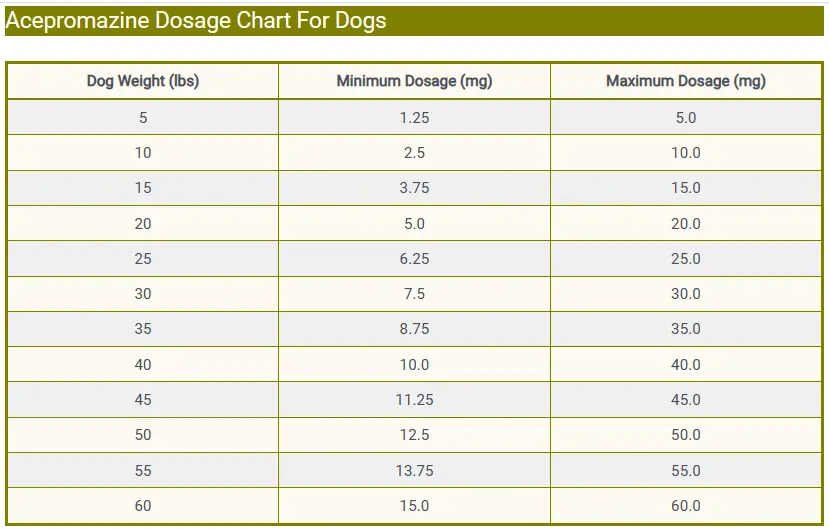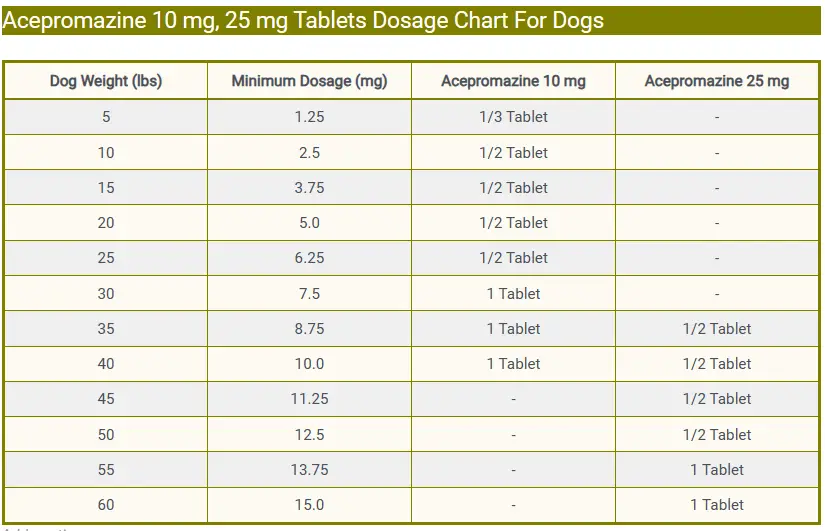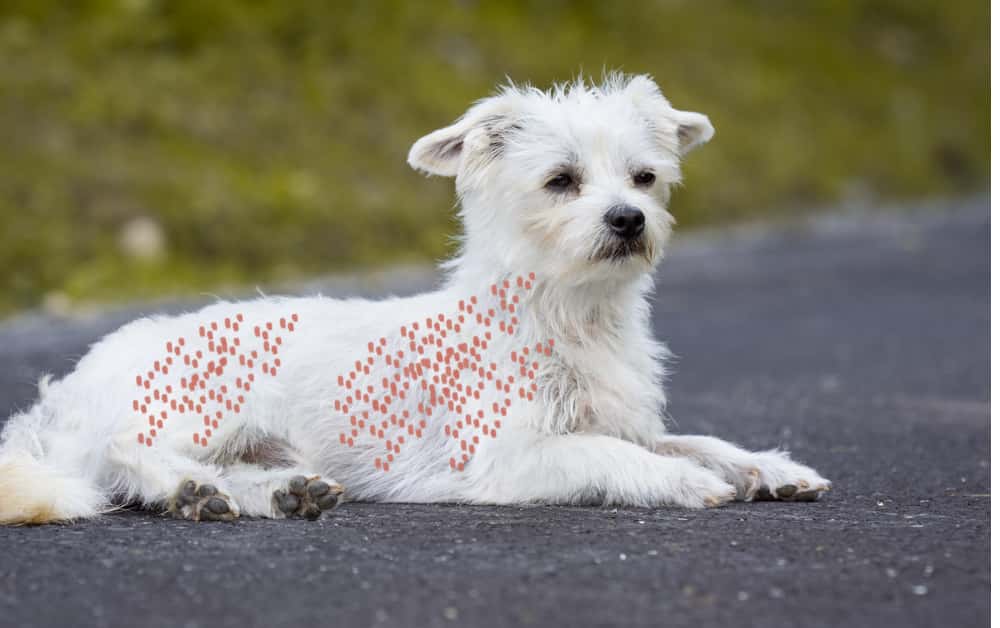The veterinarian-recommended Acepromazine Maleate dosage for dogs is 0.25 – 1.0 mg/lb (0.55-2.2 mg/kg) for use as a tranquilizer and sedative. It’s important to note that while this drug is FDA approved, federal law restricts its use to be administered by or on the order of a licensed veterinarian.
Acepromazine Maleate Dosage For Dogs

-
Ideal Dose: 0.25 – 1.0 mg/lb (0.55-2.2 mg/kg).
-
Uses: Use as a tranquilizer and sedative.
-
FDA Approved: Yes.
-
Variants: 10 and 25 mg quarter-scored tablets.
-
Brands: Acetylpromazine, ACE, ACP, PromAce®
-
Storage & Handling: 20° to 25°C (68° to 77°F).
-
Administration: Repeat as required, with at least an 8-hour gap.
Disclaimer: Self-medication can be hazardous. Please consult your veterinarian for personalized guidance on the appropriate dosage for your furry friend’s specific condition.
Acepromazine maleate, a tranquilizer commonly used in veterinary medicine, is crucial in calming anxious or excitable dogs. However, determining the appropriate Acepromazine Maleate dosage can be challenging for many pet owners and even some veterinarians.
Understanding the intricacies of acepromazine maleate dosage is essential to ensure the safety and well-being of our canine companions.
This comprehensive guide will delve into the factors influencing dosage, the effects of acepromazine maleate on dogs, and the importance of proper administration techniques.
Whether you’re a pet owner seeking clarity or a veterinary professional aiming to enhance your knowledge, this guide provides invaluable insights into the safe and effective use of acepromazine maleate for dogs.
Acepromazine Maleate Dosage For Dogs
Acepromazine maleate is a medication commonly used in veterinary medicine to sedate canines for various reasons such as anxiety, travel, or medical procedures.
The dosage of acepromazine maleate for dogs can vary depending on the dog’s weight, age, and health condition, so it’s essential to consult a veterinarian before administering any medication. However, a typical dog’s starting dosage is around 0.25 – 1.0 mg/lb (0.55-2.2 mg/kg) of body weight.
It’s essential to follow the veterinarian’s instructions carefully and never exceed the recommended dosage to avoid potential side effects or complications.
Acepromazine Dosage Chart For Dogs
| Dog Weight (lbs) | Minimum Dosage (mg) | Maximum Dosage (mg) |
|---|---|---|
| 5 | 1.25 | 5.0 |
| 10 | 2.5 | 10.0 |
| 15 | 3.75 | 15.0 |
| 20 | 5.0 | 20.0 |
| 25 | 6.25 | 25.0 |
| 30 | 7.5 | 30.0 |
| 35 | 8.75 | 35.0 |
| 40 | 10.0 | 40.0 |
| 45 | 11.25 | 45.0 |
| 50 | 12.5 | 50.0 |
| 55 | 13.75 | 55.0 |
| 60 | 15.0 | 60.0 |
Acepromazine 10 mg, 25 mg Tablets Dosage Chart For Dogs
| Dog Weight (lbs) | Minimum Dosage (mg) | Acepromazine 10 mg | Acepromazine 25 mg |
|---|---|---|---|
| 5 | 1.25 | 1/3 Tablet | – |
| 10 | 2.5 | 1/2 Tablet | – |
| 15 | 3.75 | 1/2 Tablet | – |
| 20 | 5.0 | 1/2 Tablet | – |
| 25 | 6.25 | 1/2 Tablet | – |
| 30 | 7.5 | 1 Tablet | – |
| 35 | 8.75 | 1 Tablet | 1/2 Tablet |
| 40 | 10.0 | 1 Tablet | 1/2 Tablet |
| 45 | 11.25 | – | 1/2 Tablet |
| 50 | 12.5 | – | 1/2 Tablet |
| 55 | 13.75 | – | 1 Tablet |
| 60 | 15.0 | – | 1 Tablet |
Related Post: RIMADYL Dosage For Dogs
Uses
-
Sedation for procedures like grooming or veterinary exams
-
Alleviation of anxiety-related behaviors
-
Prevention or reduction of motion sickness
-
Pre-anesthetic medication before surgery
-
Management of certain behavioral disorders
Related Post: Pepto Bismol Dosage For Dogs
Potential Side Effects
-
Sedation (can lead to lethargy or difficulty standing)
-
Hypotension (may cause weakness, dizziness, or fainting)
-
Hypothermia (can result in shivering or cold extremities)
-
Respiratory Depression (may cause shallow breathing or difficulty breathing)
-
Agitation or Excitement (paradoxical reactions)
-
Decreased GI Motility (can lead to constipation or digestive issues)
-
Allergic Reactions (itching, hives, swelling)
-
Increased Sensitivity to Light and Sound
-
Prolonged Recovery (continued sedation or disorientation)
Which Dogs Should Not Take Acepromazine Maleate
Canines with the following health issues should not take Acepromazine Maleate without veterinary recommendations.
-
Dogs with Liver or Kidney Disease
-
Dogs with Seizure Disorders
-
Dogs with Hypotension (low blood pressure)
-
Debilitated or Weak Dogs
-
Breeding or Pregnant Dogs (unless absolutely necessary and under veterinary guidance)
-
Dogs with Known Allergies to acepromazine or other phenothiazine medications











![Can Dogs Eat Blood? 7 Side Effects [Expert Opinion]](https://petskor.com/wp-content/uploads/2022/04/Webp.net-resizeimage-12.jpg)
